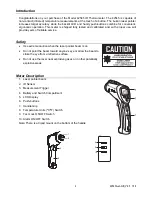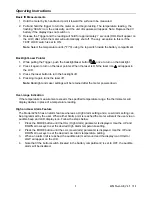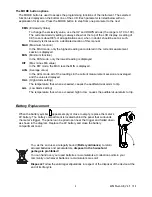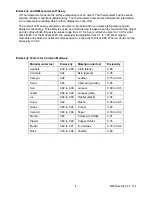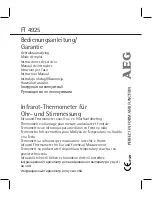
42545A-en-GB_V4.5 1/16
4
The MODE button options
The MODE button is used to access the programming functions of the instrument. The selected
function is displayed on the bottom line of the LCD. Each parameter is listed below with an
explanation for its use. Press the MODE button to step from one parameter to the next.
EMS
(Emissivity Value)
To change the emissivity value, use the UP and DOWN arrows (the range is 0.10 to 1.00).
The current emissivity setting is always shown at the top of the LCD display. A setting of
0.95 covers about 90% of all applications and, when in doubt, should be set as such.
Emissivity is discussed in a dedicated section of this manual.
MAX
(Maximum function)
In the MAX mode, only the highest reading encountered in the current measurement
session is displayed
MIN
(Minimum function)
In the MIN mode, only the lowest reading is displayed
DIF
(Max minus Min value)
In the DIF mode, the MAX less the MIN is displayed.
AVG
(Average value)
In the AVG mode, all of the readings in the current measurement session are averaged
and the value is displayed.
HAL
(High Alarm setting)
The temperature that, when exceeded, causes the audible/visual alarm to trip.
LAL
(Low Alarm setting)
The temperature that, when exceeded high to low, causes the audible/visual alarm to trip.
Battery Replacement
When the battery symbol appears empty or close to empty, replace the meter’s
9V battery. The battery compartment is located behind the panel that surrounds
the meter’s trigger. The panel can be pried open near the trigger and folded down
as shown in the diagram. Replace the 9V battery and close the battery
compartment cover.
You, as the end user, are legally bound (
Battery ordinance
) to return
all used batteries and accumulators;
disposal in the household
garbage is prohibited!
You can hand over your used batteries / accumulators at collection points in your
community or wherever batteries / accumulators are sold!
Disposal:
Follow the valid legal stipulations in respect of the disposal of the device at the
end of its lifecycle


